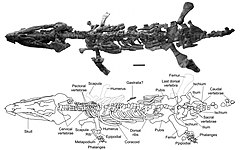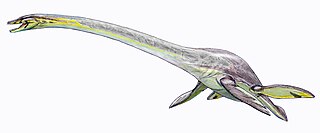
Plesiosauroidea is an extinct clade of carnivorous marine reptiles. They have the snake-like longest neck to body ratio of any reptile. Plesiosauroids are known from the Jurassic and Cretaceous periods. After their discovery, some plesiosauroids were said to have resembled "a snake threaded through the shell of a turtle", although they had no shell.

Pliosauroidea is an extinct clade of plesiosaurs, known from the earliest Jurassic to early Late Cretaceous. They are best known for the subclade Thalassophonea, which contained crocodile-like short-necked forms with large heads and massive toothed jaws, commonly known as pliosaurs. More primitive non-thalassophonean pliosauroids resembled plesiosaurs in possessing relatively long necks and smaller heads. They originally included only members of the family Pliosauridae, of the order Plesiosauria, but several other genera and families are now also included, the number and details of which vary according to the classification used.
Liopleurodon is an extinct genus of large, carnivorous marine reptile belonging to the Thalassophonea, a clade of short-necked pliosaurid plesiosaurs. Liopleurodon lived from the Callovian Stage of the Middle Jurassic to the Kimmeridgian stage of the Late Jurassic Period. It was the apex predator of the Middle to Late Jurassic seas that covered Europe. The largest species, L. ferox, is estimated to have grown up to 6.6 metres (22 ft) in length based on the largest known skull.
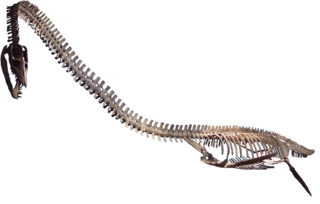
Elasmosauridae is an extinct family of plesiosaurs, often called elasmosaurs. They had the longest necks of the plesiosaurs and existed from the Hauterivian to the Maastrichtian stages of the Cretaceous, and represented one of the two groups of plesiosaurs present at the end of the Cretaceous alongside Polycotylidae. Their diet mainly consisted of crustaceans and molluscs.
Peloneustes is a genus of pliosaurid plesiosaur from the Middle Jurassic of England. Its remains are known from the Peterborough Member of the Oxford Clay Formation, which is Callovian in age. It was originally described as a species of Plesiosaurus by palaeontologist Harry Govier Seeley in 1869, before being given its own genus by naturalist Richard Lydekker in 1889. While many species have been assigned to Peloneustes, P. philarchus is currently the only one still considered valid, with the others moved to different genera, considered nomina dubia, or synonymised with P. philarchus. Some of the material formerly assigned to P. evansi have since been reassigned to "Pliosaurus" andrewsi. Peloneustes is known from many specimens, including some very complete material.

Umoonasaurus is an extinct genus of plesiosaur belonging to the family Leptocleididae. This genus lived approximately 115 million years ago during the Early Cretaceous period, in shallow seas covering parts of what is now Australia. It was a relatively small animal around 2.5 metres (8.2 ft) long. An identifying trait of Umoonasaurus is three crest-ridges on its skull.

Plesiopleurodon is an extinct genus of Mesozoic marine reptiles, belonging to Sauropterygia, known from the Late Cretaceous of North America. It was named by Kenneth Carpenter based on a complete skull with a mandible, cervical vertebra, and a coracoid. In naming the specimen, Carpenter noted "Of all known pliosaurs, Plesiopleurodon wellesi most closely resembles Liopleurodon ferox from the Oxfordian of Europe, hence the generic reference." It was initially described as a pliosaur due to it short neck, a common trait of the family, although it is in the order Plesiosauria. However, later exploration into the relationships of both orders indicate that not all pliosaurs have short necks and not all plesiosaurs have long necks.

Pliosauridae is a family of plesiosaurian marine reptiles from the Latest Triassic to the early Late Cretaceous of Australia, Europe, North America and South America. The family is more inclusive than the archetypal short-necked large headed species that are placed in the subclade Thalassophonea, with basal forms resembling other plesiosaurs with long necks. They became extinct during the early Late Cretaceous and were subsequently replaced by the mosasaurs. It was formally named by Harry G. Seeley in 1874.

Polycotylidae is a family of plesiosaurs from the Cretaceous, a sister group to Leptocleididae. Polycotylids first appeared during the Albian stage of the Early Cretaceous, before becoming abundant and widespread during the early Late Cretaceous. Several species survived into the final stage of the Cretaceous, the Maastrichtian.

Attenborosaurus is an extinct genus of pliosaurid from the Early Jurassic of Dorset, England. The type species is A. conybeari. The genus is named after David Attenborough, the species after William Conybeare.
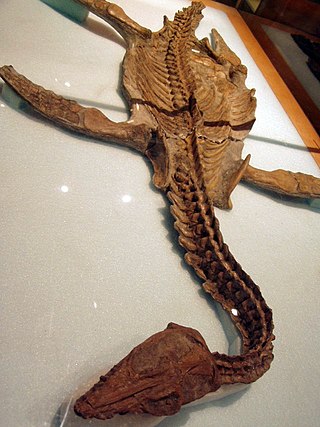
Nichollssaura is an extinct genus of leptocleidid plesiosaur from the Early Cretaceous Boreal Sea of North America. The type species is N. borealis, found in the early Albian age Clearwater Formation near Fort McMurray, Alberta, Canada.

Rhomaleosauridae is a family of plesiosaurs from the Earliest Jurassic to the latest Middle Jurassic of Europe, North America, South America and possibly Asia. Most rhomaleosaurids are known from England, many specifically from lower Blue Lias deposits that date back to the earliest Jurassic, just at the boundary with the Triassic. In fact, to date only two undisputed rhomaleosaurids were named from outside Europe - the closely related Borealonectes russelli and Maresaurus coccai from Canada and Argentina, respectively. These two species are also the only Middle Jurassic representatives of the family. Rhomaleosauridae was formally named by Kuhn in 1961, originally proposed to include Rhomaleosaurus cramptoni and its relatives, which have short necks and large heads relatively to plesiosauroids like Elasmosaurus and Plesiosaurus, but longer necks and smaller heads relatively to advanced pliosaurids like Pliosaurus and Kronosaurus.
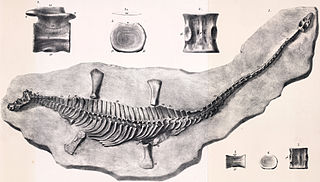
Microcleididae is an extinct family of basal plesiosauroid plesiosaurs from the Early Jurassic of France, Germany, Portugal and the United Kingdom. Currently, the oldest and the most known microcleidid is Eretmosaurus from the middle Sinemurian of the United Kingdom. Microcleididae was formally named and described by Roger B. J. Benson, Mark Evans and Patrick S. Druckenmiller in 2012.
Spitrasaurus is an extinct genus of cryptoclidid plesiosauroid plesiosaur known from the uppermost Jurassic of central Spitsbergen, Norway and likely also Kimmeridge, England. It is named after a syllabic abbreviation for Spitsbergen Travel.

Megacephalosaurus is an extinct genus of short-necked pliosaur that inhabited the Western Interior Seaway of North America about 94 to 93 million years ago during the Turonian stage of the Late Cretaceous, containing the single species M. eulerti. It is named after its large head, which is the largest of any plesiosaur in the continent and measures up to 1.75 meters (5.7 ft) in length. Megacephalosaurus was one of the largest marine reptiles of its time with an estimated length of 6–9 meters (20–30 ft). Its long snout and consistently sized teeth suggest that it preferred a diet of smaller-sized prey.
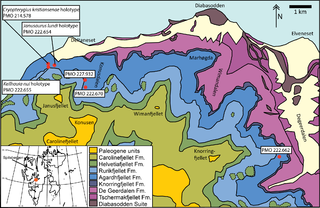
The Agardhfjellet Formation is a geologic formation in Svalbard, Norway. It preserves fossils dating back to the Oxfordian to Berriasian stages, spanning the Late Jurassic-Early Cretaceous boundary. The formation contains the Slottsmøya Member, a highly fossiliferous unit (Lagerstätte) where many ichthyosaur and plesiosaur fossils have been found, as well as abundant and well preserved fossils of invertebrates.
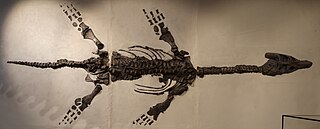
Atychodracon is an extinct genus of rhomaleosaurid plesiosaurian known from the Late Triassic - Early Jurassic boundary of England. It contains a single species, Atychodracon megacephalus, named in 1846 originally as a species of Plesiosaurus. The holotype of "P." megacephalus was destroyed during a World War II air raid in 1940 and was later replaced with a neotype. The species had a very unstable taxonomic history, being referred to four different genera by various authors until a new genus name was created for it in 2015. Apart from the destroyed holotype and its three partial casts, a neotype and two additional individuals are currently referred to Atychodracon megacephalus, making it a relatively well represented rhomaleosaurid.
Luskhan is an extinct genus of brachauchenine pliosaur from the Cretaceous of Russia. The type and only species is Luskhan itilensis, named by Valentin Fischer and colleagues in 2017 from a well-preserved and nearly complete skeleton. As an early-diverging brachauchenine, Luskhan consequently exhibits an intermediate combination of traits seen in more basal and more derived pliosaurs. However, Luskhan departs significantly from other pliosaurs in that it exhibits a lack of adaptations in its skull to feeding on large prey; its slender snout, small teeth, and short tooth rows instead indicate a skull adapted for feeding on small, soft prey. With these features, it is the pliosaur that approaches closest to the distantly-related piscivorous polycotylids, having convergently evolved these traits more than 10 million years apart.

"Pliosaurus" andrewsi is an extinct species of pliosaurid plesiosaurs that lived during the Callovian stage of the Middle Jurassic, in what is now England. The only known fossils of this taxon were discovered in the Peterborough Member of the Oxford Clay Formation. Other attributed specimens have been discovered in various corners of Eurasia, but these are currently seen as indeterminate or coming from other taxa. The taxonomic history of this animal is quite complex, because several of its fossils were attributed to different genera of pliosaurids, before being concretely named and described in 1960 by Lambert Beverly Tarlo as a species of Pliosaurus. However, although the taxon was found to be valid, subsequent revisions found that it is not part of this genus, and therefore a taxonomic revision must be carried out on this species.

